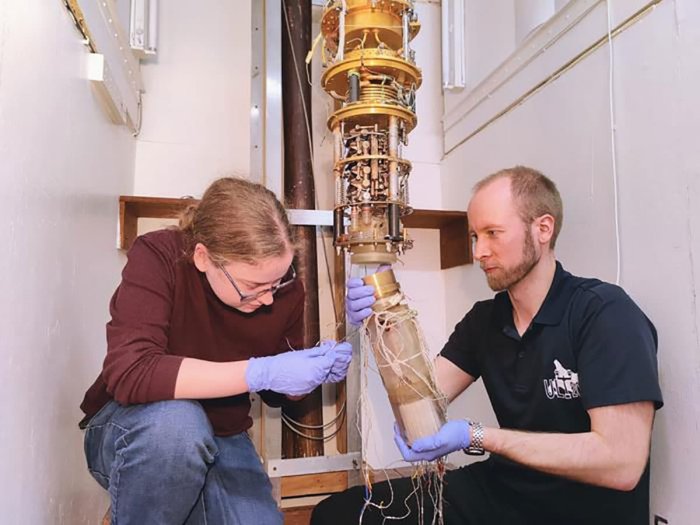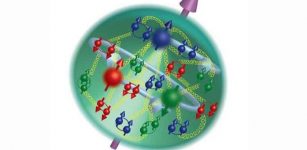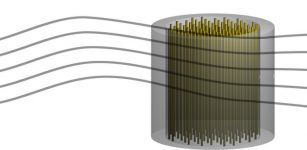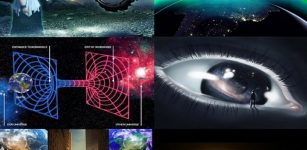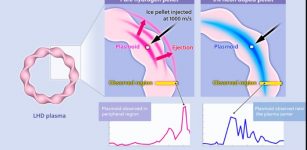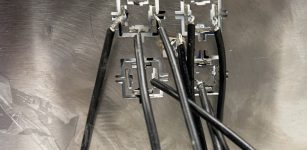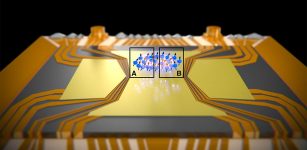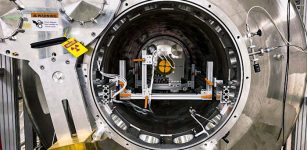Ultra-Cold Quantum Detectors Search For Dark Matter
Eddie Gonzales Jr. – MessageToEagle.com – About 80% of the universe’s matter is invisible dark matter.
It constantly passes through us, possibly trillions of particles per second. We know it exists due to its gravitational effects, but experiments have yet to detect it directly.
The experiments take place at about a 10000th of a degree above absolute zero in a special refrigerator; Dr Autti (right). Image credit: Lancaster University
Now, scientists from Lancaster University, Oxford, and Royal Holloway are using the most advanced quantum technologies to develop the most sensitive dark matter detectors yet.
The researchers include Dr Michael Thompson, Professor Edward Laird, Dr Dmitry Zmeev, Dr Samuli Autti, Dr Ian Bailey, Professor Jon Prance and Professor Rich Haley from Lancaster, Professor Jocelyn Monroe from Oxford and Professor Andrew Casey from RHUL.
Dr Autti said the team uses quantum technologies at ultra-low temperatures to create highly sensitive detectors. Their goal is to directly observe mysterious matter in the lab and solve a major scientific enigma.
Indirect evidence suggests a typical dark matter density in the galaxy, but the mass and interactions of its particles with ordinary atoms remain unknown.
Particle physics proposes two main dark matter candidates: weakly interacting new particles and light wave-like particles called axions. The team is developing experiments to search for both.
New particles with ultra-weak interactions could be detected through collisions with ordinary matter. Detection depends on the dark matter’s mass. Current searches can identify particles 5-1, 000 times heavier than a hydrogen atom, potentially missing lighter candidates.
The QUEST-DMC team aims to detect dark matter particles with masses between 0. 01 and a few hydrogen atoms. Their detector uses superfluid helium-3 and superconducting quantum amplifiers, combining quantum technologies to measure faint dark matter collision signatures.
By contrast, if dark matter is made from axions, they will be extremely light – more than a billion times lighter than a hydrogen atom – but correspondingly more abundant. Scientists would not be able to detect collisions with axions, but they can search instead for another signature – an electrical signal that results when axions decay in a magnetic field. This effect can only be measured using an exquisitely sensitive amplifier that works at the highest precision allowed by quantum mechanics.
The Quantum Sensors for the Hidden Sector (QSHS) team is therefore developing a new class of quantum amplifier that is perfectly suited to search for an axion signal.
This year’s exhibition reveals the unseeable through interactive displays for all ages. Exhibits include:
1. A gyroscope demonstrating dark matter inference from galaxy observations.
2. Glass marbles in liquid showing invisible mass detection.
3. A light-up dilution refrigerator illustrating ultra-low temperature achievement.
4. A model detector demonstrating potential dark matter behavior. These hands-on experiences creatively showcase how scientists study invisible phenomena.
Visitors can search for dark matter using a model axion detector by scanning radio frequencies and create a parametric amplifier with a pendulum.
According to cosmologist Carlos Frenk, Fellow of the Royal Society and Chair of the Public Engagement Committee: “Science is vital in helping us understand the world we live in – past, present and future. I urge visitors of all ages to come along with an open mind, curiosity and enthusiasm and celebrate incredible scientific achievements that are benefiting us all.”
Written by Eddie Gonzales Jr. – MessageToEagle.com Staff Writer

